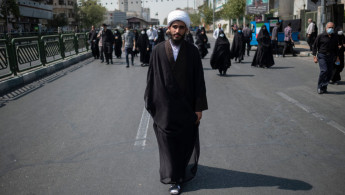Take the turban and run: an old protest tactic reemerges in Iran
Iranian youth have deployed a civil disobedience tactic, which Ayatollah Rouhollah Khomeini, Iran's first supreme leader, ordered half a century ago when he urged the youth to knock off clerics' turbans in public.
"Our youth must take off these [clerics'] turbans... I don't know if our youth in Iran are dead! Where are they? ... Why don't they take off these [clerics'] turbans? I don't say kill them. They don't worth being killed. But take off their turbans," Khomeini demanded to dishonour the clerics who supported the Shah's dictatorship.
However, as the Islamic Revolutionary Guard Corps (IRGC) and riot police tightened the noose on demonstrators, the youth began knocking off clerics' turbans in public in protest against the country's clerical governing system.
Recently, several videos were posted on Farsi social media, showing the youth throwing down the clerics' turban and running away.
Turban is considered a sacred part of the Shia clerics' outfit, as for their graduation from seminaries, a ceremony of "turban bestowal" is being held. Ridiculing this ceremony, the youth coined the term "turban hurl", which immediately gained momentum, and several Iranians shared their videos of turban hurling.
The new tactic attracted more attention in Iran when the high-ranking Iraqi Shia leader, Moqtada al-Sadr, criticised the dishonouring of clerics in Islamic countries without directly naming Iran.
"The attack on the clergy and the veil may extend to other countries," al Sadr wrote on Twitter on October 07, warning that the movement could spread to the removal of women's hijab in the Islamic world.
Since Sadr posted the tweet, this tactic attracted more attention in Iran, and a short animation video, as well as a graphic design, was created based on the videos.
"For me, turban-hurling was just something that used to make me have a good laugh," wrote one Iranian social media user. "But since Moqtada al Sadr and the IRGC reacted to that, I've considered it as a serious protest action."
With the rising number of attacks on clerics' turbans, the IRGC-affiliated Fars news agency began collecting signatures for a petition urging the government to punish those who knock off clerics' turbans.
In Iran's post-1979 revolution, it is not the first time that the turbans of clerics have been targeted for political reasons. However, on previous occasions, this act was used by hardliners against reformist clerics.
Hadi Khamenei and Abdollah Nouri were the two pro-reformist clerics who were attacked by members of the ultra-right Ansar-e Hezbollah militia and their turbans were removed in 1999.
The forces who carried out those attacks claimed to follow Khomeini’s order. In Today’s Iran, the youth fighting against the theocracy Khomeini established in Iran has deployed that same tactic, as protests continue in Iranian universities across the country.
The latest wave of anti-government uprising erupted after the death of Mahsa Amini, a 22-year-old woman, in the custody of Iran's "Islamic morality police".





 Follow the Middle East's top stories in English at The New Arab on Google News
Follow the Middle East's top stories in English at The New Arab on Google News


